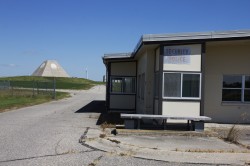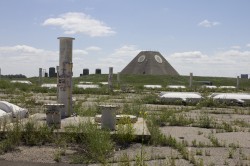Culture | August 18th, 2017

Nekoma tactical area purchased by the Cavalier County JDA
Photos by Sabrina Hornung
“These have all been cleaned and filled with sand and concrete,” said Randy Mehlhoff, who serves on both the Langdon Chamber of Commerce Board of Directors and the Cavalier County Job Development Authority (JDA), as we walked along the former nuclear launchpad that once reinforced underground launchers for sixteen Sprint and thirty Spartan nuclear-tipped missiles. The missiles were once nestled 75 feet underground. He went on to say, “One of the things we were worried about while considering buying this was if there was any pollution or nuclear reactive waste.”
The site itself was eerie, despite the blue skies, and massive wind generators moving lackadaisically in the breeze among fragrant canola fields. The site looked like a post-apocalyptic movie set, the pyramid a monolithic Cold War relic looming amidst sprawling prairie of rural North Dakota. Prairie grasses made their way through the cracks and crevices in the 40+ year old concrete between the disarmed white missile pods neatly lining a large part of the tactical area.
The grounds were once meticulously maintained by “Buzzy” Hollmann. We met Buzzy as he was circling the grounds. He approached us shortly after we got through the gate and were greeted with a direct no-nonsense stare from his icy blue eyes. Once we established that we had permission to be on the grounds his demeanor lightened up and he invited us into his pickup, giving us an exclusive tour of the grounds.
Buzzy has maintained and kept an eye on the grounds since 1992. “Our job was to keep the grounds in good shape--so if the government decided to use it they could just come back,” he said.
The Nekoma Pyramid, sometimes referred to as “Nixon’s Pyramid” is actually called the Stanley R. Mickelsen Safeguard complex. It was built between 1970 and 1975. The initial plan was three Safeguard facilities, one near Whiteman Air Force Base in Missouri and the other at Malmstrom Air Force Base in Montana. The 1972 Salt I Treaty changed everything, and the only one that was completed was Nekoma.

The total cost of the site was $6 billion. It was operational for a matter of weeks and was activated the same year it was deactivated in 1976. The initial intent of the Safeguard complex was to defend the Minuteman ICBM missile silos near the Grand Forks AFB. North Dakota’s was the only operational anti-ballistic missile system ever utilized in America.
The site takes up 447 acres. The acreage included the tactical sites, roads, the lagoon, and various buildings, including a church and bowling alley. In 2012, the site went up for auction and was purchased sight unseen by the Spring Creek Colony based in Forbes, North Dakota, in hopes of farming the acreage, but they were only able to break up 170 acres.
This summer an opportunity to buy arose yet again, but this time the Cavalier County Job Development Authority (JDA) stepped in and are currently closing on the purchase. “We are looking to purchase this tactical area -- the historic part of it -- and there’s not too much we can do with this area other than to someday make it into a tourist attraction. The rest of it is being negotiated.” Mehlhoff said.
At press time Mehlhoff stated that a purchase agreement had been signed with a company that processes hemp and flax fibers for consumer products.
“We had a meeting here one time with the Corp of Engineers, they were trying to figure out how much money it would cost to knock this building down. They came up with $155,000. One of the geniuses said--couldn’t we just take a saw and cut this top off?” said Hollmann, “I said I want to see that saw!”

Hollmann finds the thickness of the pyramid to be the most fascinating part of the Nekoma site. He pointed to the top of the building and said, “Right there it’s five feet thick but it goes down to 25 foot thick. This was built to brave a nuclear attack. The building could tilt and every floor in there was put on a rotating floor.”
He went on to say, “They all had shocks on so if the building would tip everything could still function. When I say five foot thick they had four in rebar. It was so thick you could hardly see through it. So this could really take a hit!”
He drove us past the “Heat sink.” “That was full of water and there were six big engines in there [powering the] generators and it took 1100 gallons of oil per one to change oil.” Buzzy went on to explain, “That water kept them cool and then it ran through the engines and then through the radiators of the building--that’s how they kept it warm.”
We drove past one bunker that looked like a garage door in the side of a hill. Buzzy pointed out, “This one is where they would service the chassis of the missile -- there’s a big crane in there that would pull it in, I suppose, like a car. That bunker there is where they would service the nuclear warhead.”
That day Buzzy was eagerly awaiting a wedding party. They had a string of classic cars and were looking for a photo op. He also says that the former owner gets about 20 calls a week from curiosity seekers hoping to get permission to experience the pyramid.
With the new ownership, Buzzy will continue to mow the grounds and take care of the snow removal. “I was so very proud of it; now it about breaks my heart everytime I come out here,” Buzzy said as he looked at the deteriorating buildings on the grounds.
As a tourist stop, the Nekoma pyramid will have new life breathed into it. This time it will be much less defensive.
December 18th 2025
October 20th 2025
October 15th 2025
September 16th 2025
July 29th 2025
__293px-wide.jpg)
_(1)__293px-wide.png)
_(1)__293px-wide.png)
_(1)_(1)_(1)_(1)__293px-wide.jpg)

_(1)__293px-wide.jpg)